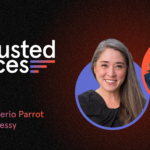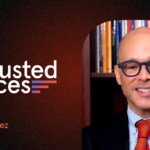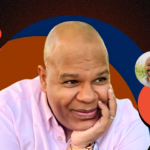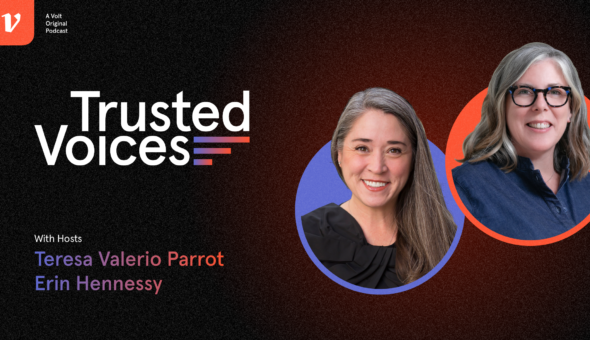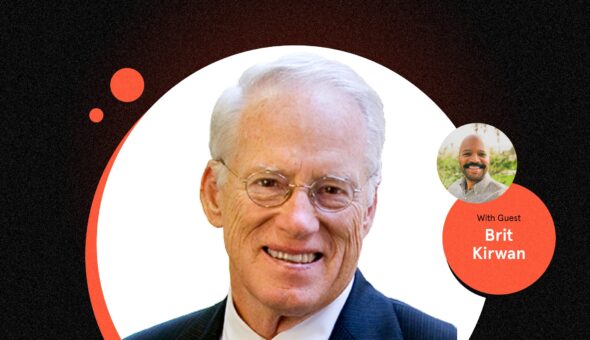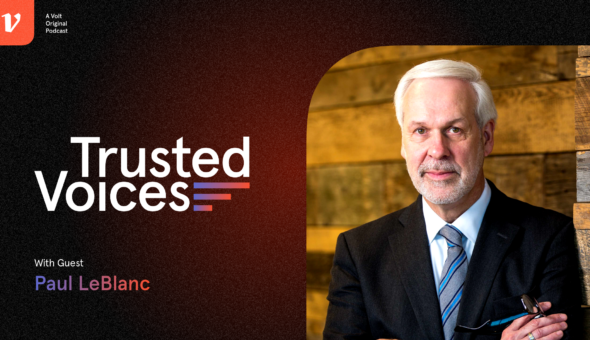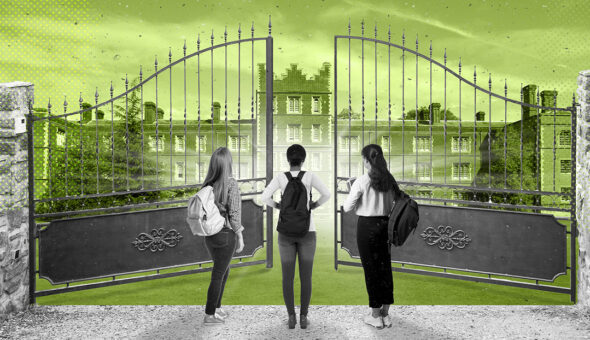Throughout Season 2, Teresa Valerio Parrot and Erin Hennessy will take time to speak amongst themselves about the major issues impacting higher ed leadership and communications. In this episode, recent events at Michigan State and West Virginia University lead Teresa and Erin to discuss the importance of engaging the communications team early in crises and highlight the significance of professionalizing leadership roles, including board professionals.
They also stress the need for self-care due to increasing burnout concerns among higher ed colleagues. With a full month of the fall term completed, higher ed leaders need to find time to recharge.
Show Notes
- West Virginia U.’s Faculty Votes No Confidence in Gordon Ge
- Michigan State football coach Mel Tucker accused of sexually harassing rape survivor
- The ‘Linchpin’ Job That Sits Between the President and the Board
Read the full transcript
Teresa Valerio Parrot:
Hello and welcome to the Trusted Voices podcast. I’m Teresa Valerio Parrot alongside Erin Hennessy, and in each episode, we discuss the latest news and biggest issues facing higher ed leaders through a communications lens. For these conversations, we’re normally joined by a guest who shares their own experiences and perspectives, but this season we’re also making time for one-on-one conversations about what we’re seeing, hearing and thinking.
With that, Erin, I know today we wanted to talk a little bit about governance and, with the start of a new year, what’s going on in our world.
Erin Hennessy:
The sexiest of topics, governance.
Teresa Valerio Parrot:
Always. It’s my favorite.
Erin Hennessy:
I know, which sets you apart in many ways, not all of them good. But when we sort of had a quick chat yesterday about what we wanted to talk about today, you were fired up about a couple of items that you had seen in the news and some experiences.
So I’m going to let you lead off, and then, I’ll jump in and “amen you” as necessary.
Teresa Valerio Parrot:
That makes me smile. I think obviously we’re starting a new academic year, and of course, we have a whole bunch of governance issues that rise to the top of discussion points as a new year starts. For us, the beginning of a new year usually means that we also visit campuses.
So, we’re not just talking about what’s in the news but also what we’re seeing and what we are actually experiencing. And it would be impossible to start this year without thinking about what’s going on at West Virginia University in the recent vote of no confidence against President Gee. But we have recently heard about allegations against the head football coach at Michigan State tied to a Title IX complaint, and that is an institution that has some governance and leadership and high-profile conversations going on for years.
I think it’s really hard for us to separate out some of these questions and not think about where does a president and a board start to play into how an institution is led, the decisions that are made and, to what we talk about, how it’s communicated.
For that point, we truly did have a spirited conversation yesterday talking about what the rules and responsibilities are for board members, whether they’re at a public or a private institution, whether they’re appointed or they’re elected, and how some of those start to shape how you do your business, including whether or not you have a leaky board, you have a leaky cabinet, you have leaky members of an administration.
So, Erin, I know you had some thoughts on some of the points that you think about tied to those, and I’m happy to join in too.
Erin Hennessy:
I just love the turn of phrase “how you do your business,” which sounds vaguely threatening in some way.
Teresa Valerio Parrot:
Well, higher education is one of the most political, and also I would say maybe the most gangster-based businesses out there.
Erin Hennessy:
I think that’s going to be a conversation for another episode: gangster-based higher ed. I mean, I think we spend a lot of time looking at higher education as an industry, and obviously, our imagination and attention gets captured by some of these really high-profile stories. This is not the first time we’ve talked about WVU this season. I almost said semester.
Teresa Valerio Parrot:
Both.
Erin Hennessy:
Yes, that, and certainly Michigan State, the hits just keep on coming, which breaks my heart for that institution. But at the same time, I think really brings up or really nicely illustrates the fact that it isn’t always the president who is responsible for issues and problems on campus. The fact that despite leadership changes and turnover and a lot of public attention and a lot of media attention, Michigan State continues to come up against these really big, really fundamental issues.
What that says to me, and I think it says to you as well, is that it isn’t just the leadership within the administration, this is also a board issue. There are some challenges that are related to how the board and the president are balancing their shared responsibilities and executing on their individual responsibilities.
That is a harder thing to tackle. We don’t often see board members getting “fired,” elected or appointed. And it becomes I think more of a generational issue for an institution because those board members tend to serve somewhat longer tenures, which also isn’t always a good thing. You and I have talked about the challenges of long-serving presidents, but I think there are also significant issues tied to long-serving board members as well.
Teresa Valerio Parrot:
I think there’s a couple of things that I’d love to unpack. One is if anybody watched the news on September 10 as it was coming out from Michigan State about allegations against their football coach and what those allegations were and what was going on, what became very apparent to me as somebody who was, I guess, Sunday quarterbacking it is that there were leaks going on. I know that because, if you followed on social media, there was a point where some reporters were saying that the coach had been fired, some were saying that he had been put on leave, and there were two different reasons given for the leave: one was the Title IX investigation and the other was behavior unbecoming a university member. That you have these different narratives coming out suggests you have some leakiness, and the leakiness is also with those who think they know what’s going on and decisions are being made elsewhere.
For me, that was something that I hope that Michigan State is going to look into and it makes me wonder if some of the timelines that we’ve seen associated with this are tied to that leakiness. But to the other point that you were making, I think there is this model that we’ve seen happening for about 10 or 15 years now where we’re shifting away from trustees, and we’re shifting more to board members in a more traditional sense. The trustees were those that we put on boards, they had indefinite terms, they may be there for a cash call if the institution wasn’t doing well through a major gift. They were really there much more for the pomp and circumstance than the friend-raising, and so many boards are still shifting or have shifted to term limits and to thinking about how board members are fiduciaries and visionaries.
Those are very different expectations and also skillsets that you need your board to have. So, I think as we look at a number of different public and private institutions right now and how we’re seeing these kind of transitions for their boards, it’s based on the fundamental roles, but it’s also based on what they’re trying to overcome that perhaps we don’t see behind the scenes.
Erin Hennessy:
I think you make a great point there, that shift from a friend of the school to really a more professionalized fiduciary approach to management and leadership of an institution. One of the things that we talk about, you and I talk about all the time is sort of institutions growing up and moving from sort of a mom-and-pop shop to a real professionalized approach to leadership, to a position in the marketplace, to effective stewardship of resources, all of those things. Seeing that happen with boards is a really encouraging sign.
This is a little bit of a detour, but I do want to mention a great piece that ran in the Chronicle this week as we’re recording that was written by Dave Jesse who, talk about the Michigan connection, is a reporter that you and I have known and followed and really admired for ages.
He writes about this really important role that I think gets overlooked so often of the board professional and what that role is meant to do and how it helps a board really professionalize and systematize its approach to the job it’s there to do. He quoted some somewhat suspect sources including … I believe you appeared in that piece. Is that right?
Teresa Valerio Parrot:
I was not in that piece, but I have to tell you, when he first got the job, I said, “You know who’s the linchpin, and you know who really is that important position on campus? It’s the board officer,” and that’s because I had that role. I have to say it was so empowering. It was an officer-level position at the institution, and you got to be in the room. And you were looking at the policy discussions that were happening and how you staff the board to be able to do their jobs.
It’s just so fundamentally important that we not think about the board staff member as the person who’s making sure that there’s coffee and hot water for tea, but instead, it is this fundamental role about the trajectory of your institution really at that behind the scenes level that really is where we also operate now too.
Erin Hennessy:
Absolutely. It’s funny, you know when I worked on a campus many, many years ago, our board professional did exactly that, the catering orders and making sure the hotel rooms were right. That’s important work. I’m not denigrating that work at all, but to see that role evolve as we’ve sort of moved into this more challenging time for higher education, I think is really important.
I know AGB spends a lot of time talking about and working with board professionals because often, I sort of, I think of it like the federal government in some ways: an administration comes in, trustees arrive, and they’re on the board for particular reasons. They bring particular expertise. But the career civil servants are the folks that are there between one administration and another, whether it changes party. And I really think of the board professional as that sort of civil servant who understands the institution but also understands the industry in a broader and more engaged way than trustees necessarily or boards of directors necessarily do because they’re coming from other industries.
So, I was thrilled to see that. We’ll include a link to that piece in our show notes once those go up, but I encourage folks to read that and to really think about how the board professional on your campus operates, how you can engage with that person and help them do their job more effectively and how they can help you do your job more effectively because that’s a great resource and a great trove of expertise right there on your campus.
Teresa Valerio Parrot:
As we move to that professionalization of other positions in the cabinet and in leadership, the other topic that you and I had that we both got pretty fired up about yesterday is that we’re seeing a dichotomy across our campuses and our clients. And again, it goes back to whether or not communications is in the room as something is starting to rise or once something happens.
I’ll just give an anecdote of a conversation I had with the president and then turn it over to you to talk about what this looks like in practice too. I was recently talking to a president and having a conversation about what happens if we have a crisis. The president asked the age-old question of “When do we bring you in? When do we bring in communications?”
She joked and said, “I think I already know your answer,” and I said, “I bet you do.” The answer is, we need to be brought in as soon as possible and we really want to be brought in before there’s an issue, when we’re just talking about the values of the institution and your leadership style and how it is that you want to approach your job and what you want the campus to be known for. That’s the first part of when you bring us in.
Then she said, “What’s the second point that you want to be brought in?” I said, “There isn’t one. You bring us in at the first point.” And I think that’s critically important because so often our colleagues, and we’re already seeing this across the country, our colleagues are brought in at the last minute to kind of do cleanup and that’s not how communications works. As we talk about, leadership and communications are so tied, and that means you’re there when the decisions are being made, not just when you need to go ahead and get some words out the door.
Erin Hennessy:
Yeah, absolutely. Approaching communications as just the folks who put out the press release is not helpful. I know there are a lot of institutions and organizations that really have taken that advice and those admonishments to heart and have made concerted efforts to say both, A, we understand this expertise isn’t necessarily housed within our institution, and/or we know that, even when we’re facing crisis, everything else still needs to get done. The dean’s list press release needs to go out, and the expert guide on the website needs to be updated, and all these things need to continue to happen.
It’s always heartening, and the stories are sort of rare. But when we hear these stories about organizations that are facing crisis and decide right up front, we need help and we need to bring help in early so that help can be part of setting strategy, help can be part of encouraging transparency and those partners that are brought in to help navigate these kinds of situations.
We’ve been in a lot of situations where we have to fight for transparency and every once in a while we have the great opportunity to be brought in to help an organization that has already decided on transparency, that has done everything right. A board that has said to the senior team, “This is how we’re going to manage it. We’re going to manage it with transparency, we’re going to manage it with openness.”
So that people look at our response to this situation and say, “You are living the advice you give others. You are living the mission of your institution or your organization, and you are understanding that the short-term challenge of navigating this news is actually going to accrue long-term benefit because you are doing what you say you’re going to do.You are living the things that you say matter to you, and on a real practical level, you are understanding that the pool for your future employees, your future leaders, your future students is out there and is looking at how you handle this situation.”
And they’re making a judgment about whether or not your organization or your institution is the kind of place they want to be connected to, in some level, maybe not consciously, but subconsciously based on how you’re navigating this crisis or this challenge.
It’s really refreshing and really empowering to work with an organization like that. You and I have had those opportunities, and we come away from them saying, “This is how it should be done. This is a case study.” I would stand up to any reporter, any stakeholder and say, “This is exactly how this should have been done. This is exactly the advice that you would give”, and this is flying in the face …
You know, we have gone through plenty of situations where someone says, “Well, they clearly bungled that response and this person should have X and that person should have Y.” We have had the opportunity to work with organizations where people do X and people do Y. And I’m not the Pollyanna ray-of-sunshine person on this podcast, but it is inspiring to work with organizations and institutions where the board and the senior leadership are united in saying, “We’re going to do this right no matter how uncomfortable it feels because that’s important long-term for the health of this organization.”
Teresa Valerio Parrot:
I think it’s important for us to say that for a lot of those organizations in those situations, y’all have never heard of what we’re talking about. That’s really difficult for people to understand because when you do leadership well, when you do communications well, when the two are really linked, people aren’t going to come out and say, “Great job,” because it shows that you are leading the institution forward and you’re doing your job. I think that’s really difficult for a number of people that are waiting for that high five. Their hand is still up in the air, and there’s nobody there giving them the high five back because we all just move on.
It’s really difficult. Sometimes we’ll say we have this great case study and people say, “I haven’t heard of it.” And that’s the point because it means that your leadership isn’t distracting from the institution doing what it needs to do for students, for employees, making sure that faculty feel supported, making sure all of the foundational items that we’re responsible for get done. That’s a tough pill to take, is that you have to go away, and you and I call each other and high-five each other so that we get that. But I feel like you have to be okay with it. It’s part of why leadership is so tough these days. There is no ticker tape parade. Instead, the work just goes on.
Erin Hennessy:
Absolutely. Now that we’ve tackled big, big questions in governance and solved all the world’s problems yet again in about 22 minutes, any last items or headlines you want to bring up, Teresa, before we go on our merry way?
Teresa Valerio Parrot:
Just something that I’m already hearing and we’re in mid-September, and so I just want to point out to all of my colleagues that the last week I’ve already been hearing a number of conversations about burnout and about how tired people are and how overwhelmed they are. Just a quick note to everybody to please remember to prioritize yourself and that we still just started the year, so let’s find a way to make this a livable experience.
I want to make sure that my colleagues who are listening aren’t just thinking about their teams because I’m seeing some really great work being done to make our work week in … I should just say work continuum, something that is survivable for their teams, but I want to make sure that it’s survivable and is pleasant for our colleagues as well. So, just give yourself a little bit of TLC if you get a chance.
Erin Hennessy:
There’s that optimistic Pollyanna ray of sunshine.
Teresa Valerio Parrot:
There you go. Had to come out.
Erin Hennessy:
As someone who is about to head out on a week of much-needed vacation myself, I appreciate and second that reminder and I hope everybody’s semester is off to at least a livable start as we head into, unbelievably, we’re just minutes from October.
With that, we want to say thank you so much for joining us this episode, this new approach to an episode for this season. A reminder that you can find links in the show notes to some of the topics and articles referenced in our conversation today, and remember that you can always contact us with feedback, questions or guest suggestions at trustedvoices@tvpcommunications.com.
Be sure to follow Trusted Voices wherever you get your podcasts, and we also invite you to check out Higher Voltage, another podcast on the Volt Network hosted by our friend Kevin Tyler. Until next time, thanks to Teresa Valerio Parrot, DJ Hauschild, Aaron Stern, Nicole Reed, and the entire Volt team for a great episode, and thank you for listening.
